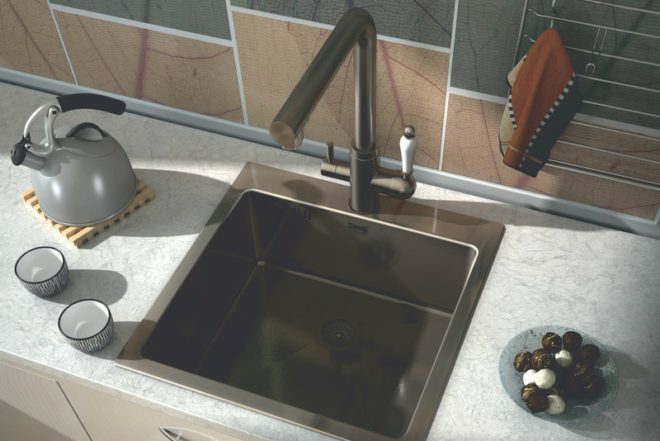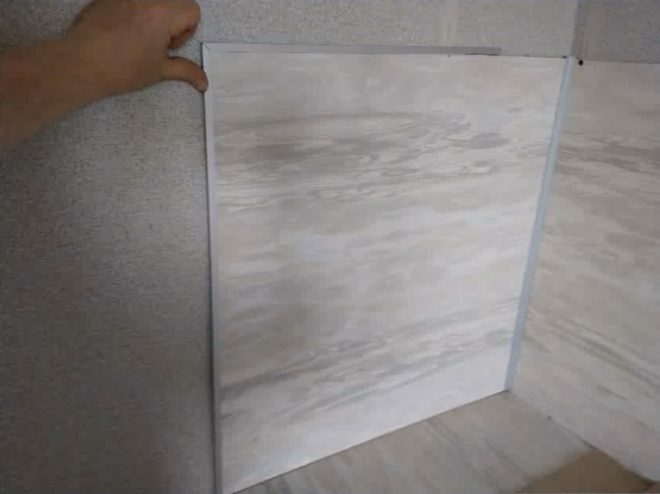- Option 1. Plastic apron made from ABSis good because it allows you to update the interior of the kitchen super-fast, low cost and without dirt. The only condition is that the plastic panel cannot coexist with the gas stove( although this is fixable).Otherwise, this is an excellent "workhorse", thermo and moisture resistant, easy to maintain and install.

However, plastic is different in terms of price and performance. Today we look at three types of plastic kitchen aprons:
- ABS plastic;
- Polycarbonate;
- PVC.
Option 1. Plastic apron made from ABS
This type of plastic apron consists of flexible and lightweight sheets made of a polymer material called the abbreviation of the three monomers Acrylonitrile, Butadiene and Styrene.


Dimensions: ABS plastic apron is sold in sheets 60 cm wide, 1.5 mm or 2 mm thick and 3 or 2 meters long. Many companies can make an apron of non-standard sizes and configurations, for example, 77 cm or 120 cm high in the drawing area.
Design: Apron made of ABS plastic is most often made with photo printing, and therefore it looks very similar to a glass apron-skinali. The image is chosen from the catalog of the manufacturer or put the print of the customer. Then the picture is covered with heat-resistant glossy or matte varnish. Another design option for a plastic apron is with a metallized mirror coating.



Installation Features: ABS plastic panels are most often mounted on liquid nails for polymers. They can also be installed using special wall profiles or screwed onto the screws.
- To install an apron made of ABS plastic, not all liquid nails are suitable, but only those designed for polymers.
Pros:
- Availability - the price of one panel with a length of 3 m is about 2000 rubles, which is much lower than the cost of an apron made of glass, MDF or tile. In addition, the kitchen apron of ABS plastic allows you to save on delivery and installation.
- The strength of on impact and bending.
- resistant to small scratches.
- The flexibility of the , due to which the apron is easily installed, even on the , the non- perfectly flat wall, as well as curved.
- Thanks to its flexibility and lightness, the apron of the is very easy to transport. is enough to roll the sheet into a roll and bring it yourself.
- Easy installation - a plastic apron can be quickly and easily installed with your own hands( on liquid nails).
- The ABS-plastic apron is not afraid of wet cleaning with aggressive cleaning agents and light abrasives.
- Decorative , the ability to apply to the panel any image or a mirror coating.
- Thermal Resistance - the material withstands heat up to 80 degrees, does not emit toxic substances during combustion and melting.
Disadvantages of a kitchen apron made of ABS plastic:
- The ABS plastic does not fit for finishing the kitchen apron with the gas stove, as it is deformed from prolonged heating and high temperatures. The material can withstand heating up to 80 degrees and only short-term heating at a temperature of 90-100 degrees.
- A weak touch with a knife is not terrible for a plastic apron, but if you touch the surface with an , a scratch or spall will inevitably appear on it .
- ABS plastic fades in the sun .
- Does not withstand contact of with acetone and solvents .
- If the base wall of the is very curve, then the plastic apron of the may lie on the waves .
- The life of the ABS panel is small and is about 3-5 years, depending on the load.
See also: How to choose a tile for the apron 12 and nuanced overview of popular formats
Option 2: Apron made of acrylic glass( polycarbonate, Plexiglas)
apron made of acrylic glass - it is inexpensive, but it is more shock-resistant and lightweight alternative to tempered glass and skinali. Externally, polycarbonate is practically indistinguishable from silicate glass - it is just as smooth, shiny and transparent.
Dimensions: Acrylic glass is 3-4 mm thick, 60 cm wide, and the standard length of one panel can be 3 or 2 meters.
Design: The apron of acrylic glass is most often decorated with photo printing, but it can also be colored( one-color) or simply transparent.
You can protect painted or decorated walls and even hanging photographs, magazine clippings, letters and postcards with transparent polymeric glass.

Ideas for self-made design of transparent polycarbonate apron
As for installation, install an acrylic apron with your own hands under the power of anyone who wants it, but nevertheless the work requires accuracy, especially since the sheet tends to bend. Holes for sockets and fasteners are made "feathers" in several approaches. If necessary, the sheet size can be adjusted with a grinding machine. An acrylic apron is installed against the wall using special fasteners for glass and mirrors, or using aluminum profiles.
Advantages of an apron made of acrylic glass:
- Acrylic glass is more transparent than ordinary glass ;
- The low cost of compared with glass skinali is from 5 tr / sq.m;
- Shock resistance ( to break and even more to break a plastic apron made of polycarbonate is almost impossible!), Flexural strength;
- does not fade in direct sunlight;
- Fireproof - polycarbonate does not ignite even with open fire, instead it melts without forming toxic substances;
- You can install the yourself.
Cons:
- In the category of kitchen aprons made of plastic acrylic skinali - is the most expensive material .
- Acrylic apron does not tolerate cleaning with abrasives and aggressive cleaning agents .
- It is not recommended to use near the gas stove.
See also: Guide for choosing an artificial and natural stone for finishing an apron
Option 3. Apron made of PVC
If you need a super-economical and quick solution, for example, to finish the apron of a country house kitchen or a rental housing, then we suggest you look at the wall panels made of polyvinyl chloride. PVC aprons come in two formats: sheet and lath( in the form of lining).
Dimensions: The most common panel format is 950x480x3 mm, paneling is 3000x100x10 mm, 3000x100x12.5 mm, 3000x195x12 mm and others.
Design: The panels are sold with a ready-made design - with patterns and pictures applied by offset printing( drawing + protective varnish).Also, PVC apron can imitate natural finishing materials, for example, brickwork, mosaic, leather, stone, etc. Lining can be white, “wooden”, “stone”, sometimes it is complemented with patterns and colored / metallized edging. PVC apron coating can be glossy( laminated panels) or matte.
- The durability of glossy panels is slightly higher than matte.

Installation Features: Their PVC kitchen apron is mounted on glue, liquid nails or screws. At will PVC-lining can be laid as vertical rows, and horizontal.
Pros PVC apron:
- The ease and speed of installing do-it-yourself;
- Low price - 160-300 rubles per square meter.m.
. Cons of a kitchen apron made of PVC:
- . Low resistance of the to mechanical damage and abrasion.
- Over time, will fade and turn yellow from exposure to sunlight and cleaning products.
- Low Temperature Resistance : deforms at temperatures above 80 degrees, easily ignites, and low-quality PVC can emit toxic substances when burning.
4 councils for choosing a plastic apron for the kitchen
Tip 1. When buying a plastic apron, make sure that it has a quality certificate and is suitable for decorating kitchen walls, that is, at least does not emit toxic substances( including burning / melting), hasmoisture and heat resistance.
Tip 2. The life of any plastic apron can be significantly extended if you additionally install a transparent glass screen in the area of the plate( above the apron as shown in the photo below).So you save the panel from grease and dirt and, accordingly, from cleaning and detergents. In addition, the glass screen will be able to protect the plastic from the open flame of a gas stove.

Speaking of a gas stove. It is believed that a plastic apron is incompatible with it, but this is not entirely true. If desired, you can install the plate at a distance of 15 cm from the apron or install a glass screen, as we have already noted above.
Tip 3. Most often, plastic panels are decorated with photo printing - patterns, textures, beautiful photos or drawings. Such a striking design should be chosen much more carefully than ordinary tile or MDF, otherwise the apron will make the interior coarse and quickly get bored. Here are two main principles that should be followed:
- The kitchen apron should overlap with the color scheme and style of the interior as a whole. For example, the color of the panel can be matched to the tone of the facades of the headset and / or other elements of the decor, say, to the tone of curtains or wallpaper.
Afraid to go wrong with color and design? Choose a neutral apron, such as white, light gray or beige, possibly with a simple floral or geometric print( rhombus, stripes, checkered).But dark colors should be avoided - even the smallest speck of dust or a drop of water will be noticeable against their background.

- The more complex, more detailed and multicolored the interior of the kitchen, the more concise should be the design of the apron. If the walls are covered with bright wallpaper with a pattern or the facades of the headset is decorated with gold-plated carvings, then the apron is better to choose a plain or with a discreet pattern.

The laconic design of the kitchen apron made of plastic
If the kitchen set and the interior are minimalist, then the plastic apron can and should be chosen bright.

Tip 4. Want to be able to change the design of the apron according to your mood? This is possible with a double-sided apron made of ABS plastic or PVC, which is installed not by glueing, but by using wall profiles. Double-sided apron can be purchased at IKEA or ordered in some workshops, the profiles are sold in building hypermarkets and in the same IKEA.

sided plastic apron IKEA
Mounting plastic apron with his hands
To install the apron of plastic panels, sheets or lining their own hands, you need to perform the following actions:
- Determine the dimensions of the apron - it should be such as to overstep the table top by 1-3 cm, but in height from the table top to wall cabinets, it can be anything - directly to the level of cabinets, go behind them a little or be lower. In the latter case, you need to properly seal the joint between the sheet and the wall and decorate the visible ends of the molding;
- We cut plastic panels, sheets or wall paneling with a small hacksaw. Some panels are cut with a regular cutter as shown in the photo below.

- Fix the panel on the wall. This can be done in three ways:
- Express-way: just glue the plastic to the wall on liquid glue, which is applied to the wall and panels with a distance of about 15 cm between the glue strips. This method is good if the panels are glued only on the apron, and not onwhole wall / walls, otherwise dismantling will be problematic. In addition, it is advisable to glue the panels onto the substrate prepared in the following sequence: primer, leveling and sealing the gaps with plaster to a satisfactory or good condition( you can not bring to ideal), then after the plaster dries, the primer is applied again.

- Installation on screws: you can fasten the apron at the corners on the screws.
- Fastening to metal profiles: it is best to make the apron removable, for this you need to fasten special metal strips for wall panels to the wall using the same screws as in the photo on the right. They allow you to easily change the apron if necessary or desired.
Photo Gallery
( Rate this material! Already voted: 49 Average rating: 4.31 out of 5)














Loading. .. Support the project - share the material with your friends on the social networks:17.9% 100% 100% 100)and walls
- How to choose an apron for the kitchen - help for the buyer
- and before do-it-yourself
- MDF wall panels for the apron and kitchen walls
Apron on the kitchen of plastic - information for the buyer
Contents

Design of an apron for a kitchen made of ceramic tiles: photoApronRepair OfKitchen Design
The interior consists not only of furniture and any accessories (read also about its choice here). Ceilings, floors, walls (viewed here) are also directly related to the decor. Especially you will ...
Read More
Wall panels for the kitchen: review of materials, cost, photoDesignApronKitchens
Wall panels for the kitchen are a real lifesaver. This cladding material will help in many cases. Uneven and crumbling walls are easy to fix with inexpensive materials that hide all flaws in one fe...
Read More
How to attach a kitchen apron (wall panel) with your own hands?DesignApronKitchens
The wall near the stove, sink and work surface of the table is most susceptible to aggressive factors: water gets here, splashes of fat, it often heats up. To protect this part, install a kitchen a...
Read More


















